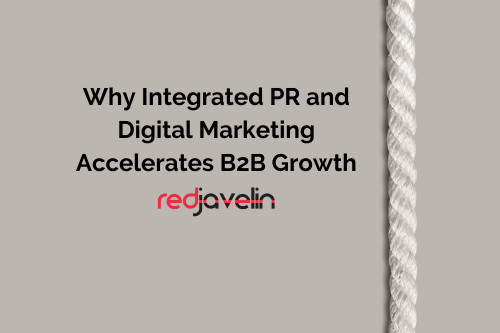 Today, the lines around B2B marketing and PR are more blurred than ever. Both strategies are used by businesses to communicate and engage with other businesses but understanding the differences between the two and how they work together to meet your business goals is the key to supercharging your marketing efforts.
Today, the lines around B2B marketing and PR are more blurred than ever. Both strategies are used by businesses to communicate and engage with other businesses but understanding the differences between the two and how they work together to meet your business goals is the key to supercharging your marketing efforts.
Before I move into discussing the differences, let's review one of the most important marketing tenets today – the 95-5 rule. This rule states that only 5% of your total addressable market is "in market" (looking for a solution) at any given time. Depending on whose stats you believe, B2B buyers complete 60-85% of the buying cycle before they talk to a salesperson. So, if the buyer doesn't know who you are before going "in market, " you have already lost the deal.
Key differences between the two include:
Focus and objectives
- B2B digital marketing primarily promotes and sells products or services to other businesses. Its main objective is to capture the attention of potential customers and encourage them to express interest in your offerings. Delivering the right messages at the right time will drive traffic to your website, generate leads, and drive sales by using tactics such as content marketing, social media, advertising, and email marketing.
- On the other hand, B2B PR is focused on managing a business's public image and reputation. Its primary objectives include building brand awareness, establishing thought leadership, and maintaining positive stakeholder relationships. Earned media from media coverage, press releases, and featured articles helps companies reach a broader audience, including potential customers, partners, investors, and positions the company and executives as thought leaders. Companies can establish themselves as knowledgeable and influential players in their field by sharing insights, expertise, and unique perspectives through interviews, guest articles, or speaking engagements, differentiating themselves from competitors, and creating valuable networking opportunities.
Communication channels and tools
- B2B marketing typically employs a variety of channels to reach its target audience, including advertising, content sponsorships, email, organic and paid social media, and more. The emphasis is on supporting the sales process with lead generation and conversions by providing valuable resources and materials that help sales teams educate and persuade potential customers. Marketing collateral, product documentation, white papers, and online demos equip sales representatives with the tools to communicate the value of offerings and close deals effectively.
- B2B PR uses different channels to shape the perception of the business and build relationships with stakeholders. It often involves media relations, press releases, industry events, thought leadership articles, interviews, and other tactics that help enhance the brand's reputation and credibility.
Messaging and content
- B2B marketing messages are often product or service-oriented, focusing on the features, benefits, and value proposition for potential customers. Content may include product demonstrations, case studies, pricing information, and targeted promotional campaigns.
- B2B PR can give companies a competitive edge in crowded or fractured markets. By effectively communicating their unique selling points, competitive advantages, and success stories, startups can differentiate themselves from competitors and attract the attention of potential clients. We have a Messaging Blueprint process that drives the content we create for our clients. Content may include press releases, white papers, industry reports, expert opinions, and corporate social responsibility initiatives.
Establish Trust & Credibility through Relationship Building
- B2B marketing aims to identify potential customers, nurture leads, convert them into paying customers, and build credibility and trust among its target audience. Through consistent marketing efforts, B2B companies can demonstrate their expertise, showcase their successes, and establish themselves as reliable and trustworthy partners.
- B2B PR focuses on building and maintaining relationships with various stakeholders in the ecosystem, including industry influencers, journalists, analysts, investors, and customers. The goal is to establish trust, credibility, and positive brand perception. PR activities, such as positive media coverage, industry awards, or endorsements from industry experts, can enhance a B2B company's credibility and reputation. This helps to build trust among potential clients, who are more likely to engage with a startup that has been endorsed or recognized by reputable sources. Often, PR helps form strategic partnerships and collaborations as media exposure and industry recognition attract the attention of potential partners, investors, or acquirers who may be interested in aligning themselves with a promising startup. PR activities can serve as a platform to showcase the startup's value proposition and open doors to valuable business opportunities.
Measuring success
- B2B marketing success is easy to measure once your programs have started. There are various metrics depending on the campaigns you are running, but they are typically measured by the number of qualified leads, conversion rates, customer acquisition costs, return on investment (ROI), and revenue growth.
- B2B PR success is not as easy as calculating how many people clicked on ad banners. When measuring brand awareness, thought leadership, and authority, it requires more of a long-term outlook. Metrics used include media mentions, brand sentiment, share of voice, potential reach, earned media value, thought leadership recognition, industry awards, and speaking opportunities.
Overall, PR is a powerful tool for B2B startups to build brand awareness, establish credibility, attract partnerships, and ultimately drive business growth. By leveraging marketing strategies and techniques, B2B startups can effectively promote their offerings and accelerate their growth trajectory in competitive markets. By effectively leveraging PR strategies, startups can maximize their chances of success in the competitive B2B landscape.
Why Integrated PR & Marketing for Emerging Growth B2B Companies
For several reasons, emerging growth B2B companies should use integrated marketing and PR (public relations) strategies. While B2B marketing and B2B PR have distinct differences, they often work together as part of an integrated marketing and communications strategy. The two functions collaborate to align messaging, amplify brand reach, and achieve common business goals. Here are some key benefits:
- Enhanced Brand Awareness: Integrated marketing and PR help B2B startups build and strengthen their brand identity. By combining various marketing channels and PR efforts, such as social media, content marketing, media relations, and events, companies can increase their visibility and reach among their target audience. This heightened brand awareness can lead to increased recognition and credibility in the market.
- Increased Lead Generation: Integrated marketing and PR tactics can effectively generate leads for emerging B2B companies. Companies can attract and engage potential customers by utilizing a combination of marketing channels, such as PR campaigns, inbound marketing, search engine optimization (SEO), and advertising. Integrated efforts allow for a consistent brand message and a cohesive customer journey, leading to improved lead generation and conversion rates.
- Thought Leadership and Expertise: PR initiatives, such as securing media coverage and contributing to industry publications, position B2B companies as thought leaders and industry experts. Thought leadership contributes to brand differentiation and increases customer loyalty and business opportunities. By sharing valuable insights, trends, and innovations, startups can establish credibility and gain the trust of their target audience.
- Relationship Building: Integrated marketing and PR strategies enable B2B companies to build and nurture relationships with key stakeholders, including customers, partners, industry influencers, and media outlets. Engaging in ongoing communication, targeted email marketing, personalized campaigns, hosting events, participating in industry conferences, and leveraging social media platforms allows companies to connect with their target audience on a deeper, more engaged level, fostering long-term relationships, loyalty, and repeat business.
- Crisis Management and Reputation Protection: PR plays a crucial role in managing crises and protecting the reputation of B2B companies. An integrated approach using PR and digital marketing tools ensures a coordinated and strategic response during a crisis. By promptly addressing issues, crafting appropriate responses, communicating transparently, and leveraging various communication channels with all stakeholders, companies can minimize the negative impact on their reputation and maintain the trust of their stakeholders.
- Measurable Results and ROI: Integrated marketing and PR campaigns allow startups to track and measure the effectiveness of their efforts. By utilizing analytics, monitoring key performance indicators (KPIs), and conducting regular assessments, B2B companies can gain insights into what works and what needs improvement. This data-driven approach enables them to optimize their marketing and PR strategies, allocate resources efficiently, and demonstrate a return on investment (ROI) to stakeholders.
Overall, integrated marketing and PR strategies help start-ups and emerging growth B2B companies establish a strong market presence, generate leads, build relationships, manage reputation, and achieve sustainable growth so when a prospect is ready to buy - go "in market" - you are already on the shortlist. By combining various tactics into a cohesive and coordinated approach, they can maximize their impact and stand out in the competitive B2B landscape.




